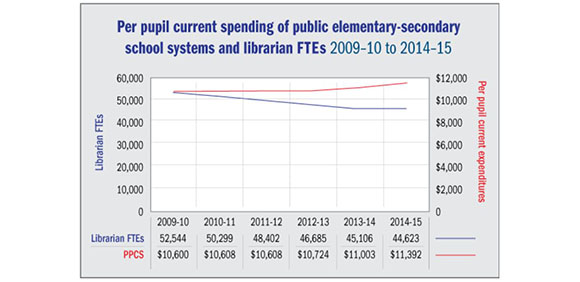
School Library Journal recently published the School Librarian State of the Union. This national overview of the profession takes a look at the data gathered about school librarianship. One of the articles, “A Perfect Storm Impacts School Librarianship Numbers,” uses this data to reflect on the national, state, and local factors that together contribute to the dropping number of school librarians.
Nationwide, the school librarian profession has lost about 1 in 5 (19%) full-time positions since 2000, translating to about 10,000 jobs. One explanation for this loss could be a trend of not replacing school librarians when they retire, and many school librarians are retiring – more than 3 in 5 (63%) librarians in 2016 were 54 years old or older. Another national trend is taking place in LIS programs. Over the past five years, the number of school library certification programs has dropped by about a third (32%).
On a state level, spending on U.S. schools has risen slightly for the second year in a row but has not matched the increasing student population and the rising costs of providing educational services. Between 2010-2015, the average per pupil spending in public schools rose by 7.5% while school librarian positions were cut by 17%. School librarian positions are often vulnerable to being cut because less than half of states (22) have legislative regulations requiring schools to employ a school librarian.
Locally, there is a lack of knowledge among school administrators about the impact of school library programs and certified librarians on student success. Only 1 in 10 (10%) principals report receiving formal training related to school librarians, and they said that most of their knowledge came from face-to-face interactions with school librarians.
The entire School Librarian State of the Union can be found here.
Note: This post is part of our series, “The LRS Number.” In this series, we highlight statistics that help tell the story of the 21st-century library.